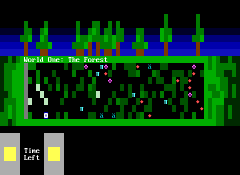With most games today, after playing it long enough, there will be nothing new to extract from it. You'll find all the secret items and characters, find the hidden levels, and know where everything is located at. Yet a noteworthy exception is Wil's Run-On.
If you started the game as an embryo in the womb, you'd still be playing a different game at the Pearly Gates. Wil accomplishes this almost god-like feat by using complete randomness. And to skip doing an entire section on the beneficial (yet sometimes overrated) replay value, I'm going to give you number crunchers a little equation: Randomness = Infinite replay value. Terrain is randomly generated as you progress through levels, which means you have to clear forest, shoot breakables, and run to the other side of the screen. It's like putting your CD player on random; you know what you're going to get, but the order it will come in will play itself out through the progression of the game.
But what's the running for? Well, the answer is this: evil. Your character, upon an abrupt revelation, is being pursued by evil and must constantly outrun it by running in specified directions, yet after a length of time, you will be "pulled" in the opposite direction, simulating the evil catching up with the player. You have to hustle, for the only alternative is death. Along with evil, you have an array of enemies, either pre-programmed or amusingly original, such as lions, tigers, bears, newbies, a drunk, cactuses, and an insane taxi driver. You have to be quick with your gun to ward off these adversities.
Wil also puts the player through a string of contrasting lands and worlds. They range from a shoot-and-run, to a side-scroller, to a flag based board. Wil takes the random duengon concept, and builds on it further, with delightful results. You'll find your attempt to escape from pursuit will take you to a pub, the clouds, a multicolored realm, and more. The worlds are brightly portrayed in Wil's bold graphics. His use of the ZZT colors has the ability to evoke even the grittyness of an alleyway or the sun beating down on you in the desert. In fact, part of the fun in Run-On is seeing what strange location you will enter next and what you are expected to accomplish to exit it. The 15 different locations to pass through makes the entertainment value of the game top notch.
The ending of the game is rather open ended, yet this is a benefit of the game. For it is not the destination that matters, but the journey. The ending is not as much of a conclusion to the plot as it is a revelation. The ending places a very familar image in relation to the game, and the comparison of the two subjects is very deep. It is much more powerful than a clear, ironed out resolution, it compells the player to sit there, staring at the screen, and think it over for a few seconds, for me a few minutes. And in a age of gaming where constant action is repititious and attention spans are at a low for some, these few moments are golden.
For some icing on this ascii cake, the game also contains a mini game by Kkarios, DGN Ultimate, which is also randomly generated. But "mini" is hardly the word to describe it. With 100 levels total, expect this game to supply an additional hour of enjoyment.
You'd be missing out on a lot of what makes a great ZZT game magnificent if you do not download Run-On. But I have some basic instructions for you to avoid that: download Run-On, press "P", play, repeat. You can thank youself later for it.









